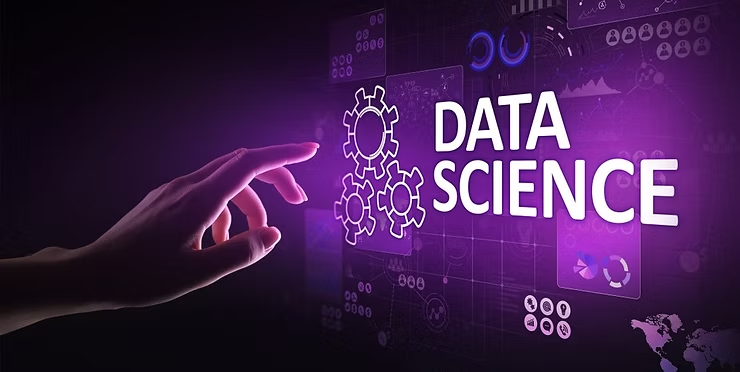Introduction
Modern technology is powered by disciplines of data science and artificial intelligence that are very similar. Mostly, data science involves gathering, filtering, and interpreting data. It reveals patterns and knowledge that support sensible choices. AI, or artificial intelligence, automatically learns and accomplishes tasks using these information. Together they let computers improve over time and solve difficult problems. Businesses use this mix to maximize operations, improve consumer experiences, and generate innovative ideas in sectors including healthcare, finance, and technology. Data Science Training in Gurgaon helps professionals build strong analytical skills and practical knowledge.
What Is Data Science?
Data science is a field that focuses on collecting, organizing, analyzing, and understanding data. Think of it like solving a puzzle. A data scientist looks at many small pieces of information and tries to find patterns or answers.
For example, when a company wants to know what products people like, data scientists study sales numbers, customer reviews, and social media posts. Using this data, they can suggest which products to sell more or which ads to run.
Data science uses tools like:
- Statistics
- Programming (like Python or R)
- Data visualization (charts and graphs)
- Machine learning (a part of AI)
In simple terms, data science helps turn big, messy information into clear answers that can help people or companies make better decisions.
What Is Artificial Intelligence (AI)?
Artificial Intelligence, or AI, is a branch of computer science that focuses on building machines that can do things that usually need human intelligence. This includes tasks like:
- Recognizing faces
- Understanding speech
- Playing games
- Making decisions
- Driving cars
AI systems learn from data. They don’t need to be told every step. Instead, they study past examples and use them to understand new situations. For instance, an AI trained on many photos of dogs and cats can learn how to tell them apart just by looking at new images.
AI uses something called “machine learning,” which allows it to improve over time. The more data it gets, the better it becomes.
How Data Science and AI Work Together
Now, let’s understand how data science and AI team up. Data science acts like the brain that prepares the information, and AI is the smart tool that uses it.
Here’s how it works in simple steps:
1. Collecting Data
First, data scientists collect data. This can come from websites, sensors, cameras, apps, or almost anywhere. Without data, AI can’t learn.
2. Cleaning and Organizing Data
Raw data is messy. It may have missing parts, mistakes, or be in the wrong format. Data scientists clean and arrange the data so that it’s ready to be used.
3. Analyzing and Understanding Patterns
Using tools and statistics, data scientists look at the data to find useful patterns. This helps them know what matters most and what can be ignored.
4. Feeding Data into AI Models
Once the data is clean and ready, it’s given to AI models. These models learn from the data. The better the data, the smarter the AI becomes.
5. Making Predictions or Decisions
After training, the AI can make decisions or give predictions. For example, it might predict what product a customer might want next or spot a disease in a medical scan.
6. Improving with Feedback
Data science doesn’t stop after AI makes a decision. New data comes in, and scientists study it to check if the AI was right or wrong. This helps improve the AI over time.
Data Science And AI
Data science and artificial intelligence are changing how we interpret and consume data. Data science seeks to gather, analyse, and then explain vast quantities of data. By finding patterns and ideas, it aids firms in making more informed choices. AI, or Artificial Intelligence, reproduces human intelligence in devices.
It may predict, spot patterns, and study from data. Artificial intelligence and data science collaborate to enable automation and more sophisticated solutions. Companies use these technologies to produce unique items, simplify processes, and enhance consumer experiences. AI models can analyse intricate data more rapidly than humans. These models are created by collaboration between data scientists and AI specialists.
To ensure reliable outcomes, they educate systems, choose algorithms, and purge data. Studying artificial intelligence and data science provides chances in predictive modelling, machine learning, and analysis across several sectors including banking, retail, technology, and healthcare. Data-driven techniques help experts in this field to solve actual problems.
Together, data science and artificial intelligence help to address difficult issues. Understanding and preparation of data are the mainstays of Data Science. AI employs this data to automate processes and make predictions. Both disciplines depend on sophisticated algorithms and solid data management. Merging them results in smart systems able to grow better with time.
Data Collection and Preparation
Gathering data from several sources is the first step. Databases, sensors, web applications, or social media might provide this data. Data scientists eliminate anomalies and mistakes by cleaning the data. They turn unprocessed data into an organized form fit for analysis. AI algorithms require this pure data in order to run properly. Unprepared, artificial intelligence models can give incorrect results.
Data Analysis
Data Scientists examine data to detect patterns and trends after it is ready. Statistical approaches and visualizations are employed by them. This examination aids in comprehension of relationships inside the data. Using these insights, artificial intelligence systems may then acquire knowledge from past information. The usefulness of artificial intelligence models depends on the accuracy of analysis.
Feature Selection and Engineering
Data science is choosing the most relevant variables for artificial intelligence models. New variables produced by feature engineering enhance predictions. Because AI models work better with relevant and well-structured data, this stage is absolutely essential. To maximize model performance, data scientists play with several traits. Data Science Online Training offers flexible learning options for students and working individuals.
Machine Learning and Model Building
The prepared data is utilized by artificial intelligence to train machine learning models. Based on the sort of challenge, Data Scientists pick appropriate algorithms. The models make forecasts based on patterns found in the data. AI can, for instance, categorize pictures, spot fraud, or forecast consumer behaviour. Data science guarantees correct data properly organised for effective learning.
Model Evaluation
Data scientists examine the performance of their model after creating one. Metrics like accuracy, precision, recall, and F1 score are used. Assessment guarantees that AI models produce trustworthy results. Data Scientists improve the model or modify data characteristics if performance is poor. This repeated method helps artificial intelligence make better decisions over time.
Deployment and Automation
The model is used in practical uses after it is dependable. New data enables artificial intelligence systems to now create automatic decisions. Data science continuously checks and updates the information to keep it accurate. Through this partnership, companies may continuously acquire knowledge and automate operations.
Continuous Learning and Improvement
As artificial intelligence systems handle more data, their development is enhanced. By gathering and organizing ongoing data streams, data science helps this. Constant observation guarantees that artificial intelligence algorithms evolve with trends or patterns. This mix lets companies remain innovative and competitive.
Industry Applications
Several sectors use data science and artificial intelligence in conjunction. In healthcare, they improve therapies and forecast patient outcomes. In finances, they identify fraud and predict market patterns. Retail businesses employ them to control inventory and acquire knowledge of consumer behaviour. Using artificial intelligence models, manufacturing companies use predictive maintenance. These uses highlight the power of merging artificial intelligence and data science.
Conclusion
For artificial intelligence systems, data science readies and organizes data. Learning, predicting, and automating tasks depend on artificial intelligence. Data Science coding Interview Questions prepare candidates to tackle real-world technical challenges effectively. Their cooperation fuels smart ideas in medicine, healthcare, finance, and beyond. Systems created by experts proficient in both disciplines can constantly get better. Data science and artificial intelligence combined turns unprocessed data into useful insights and intelligent decision-making.










